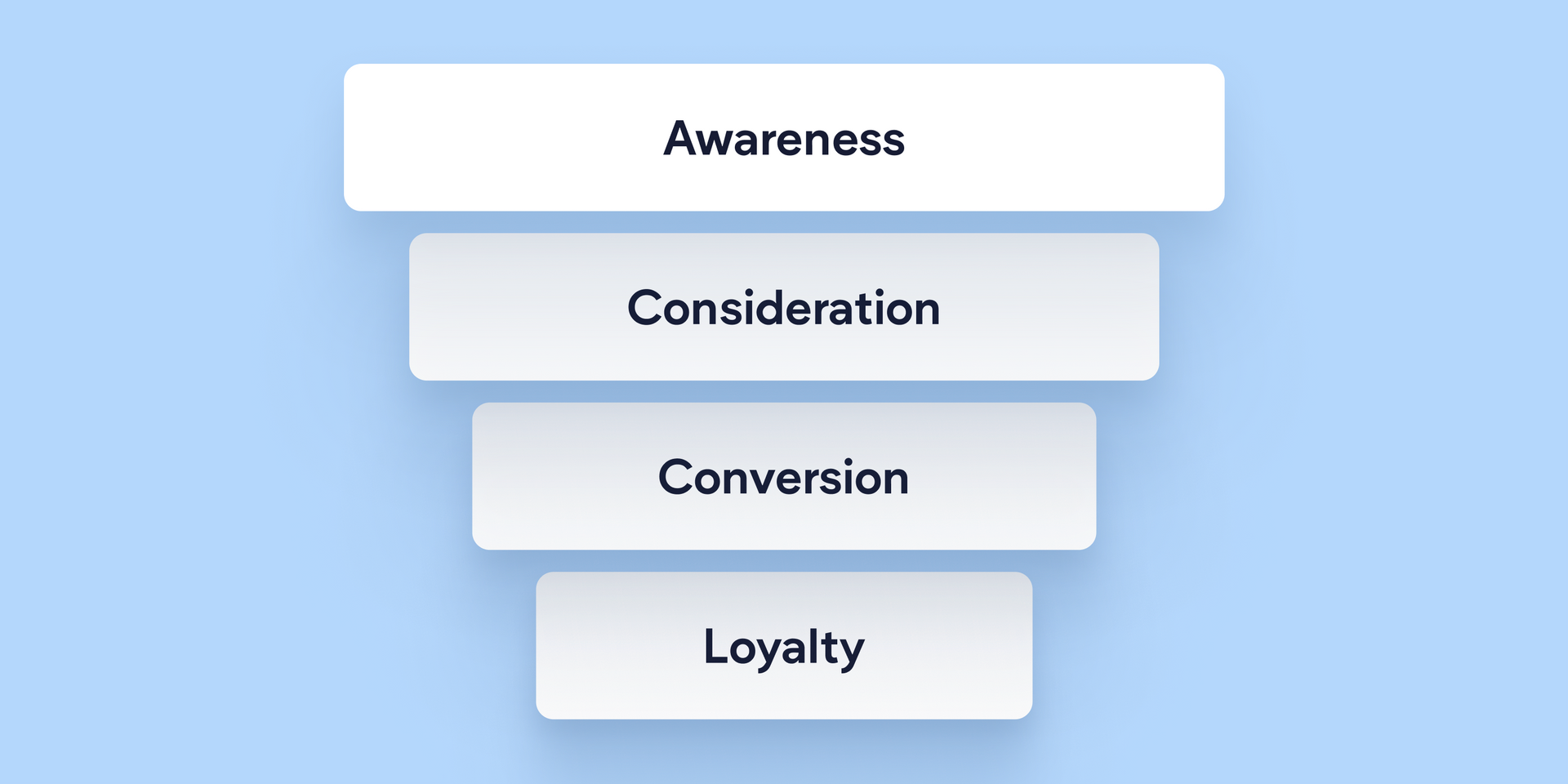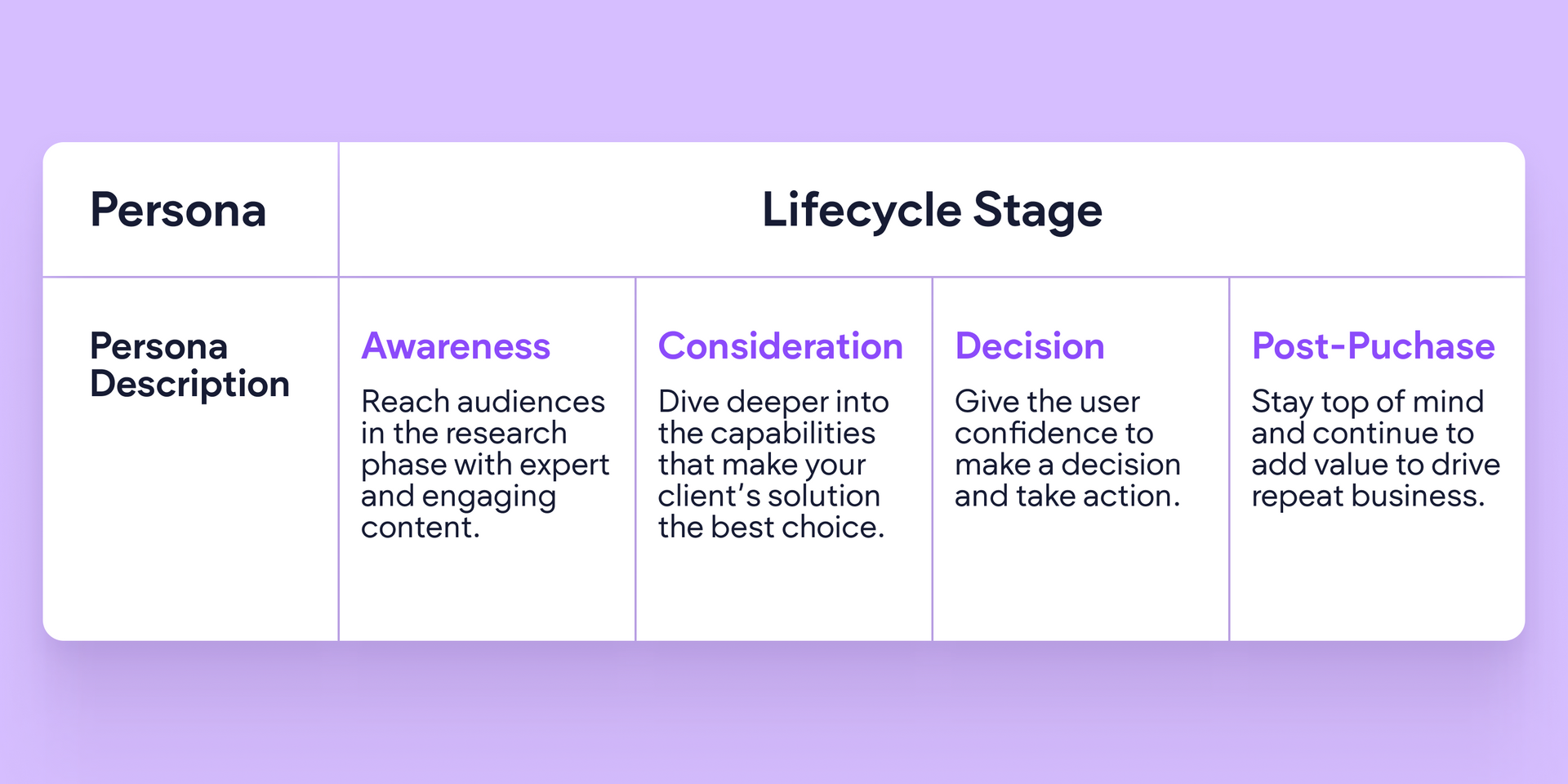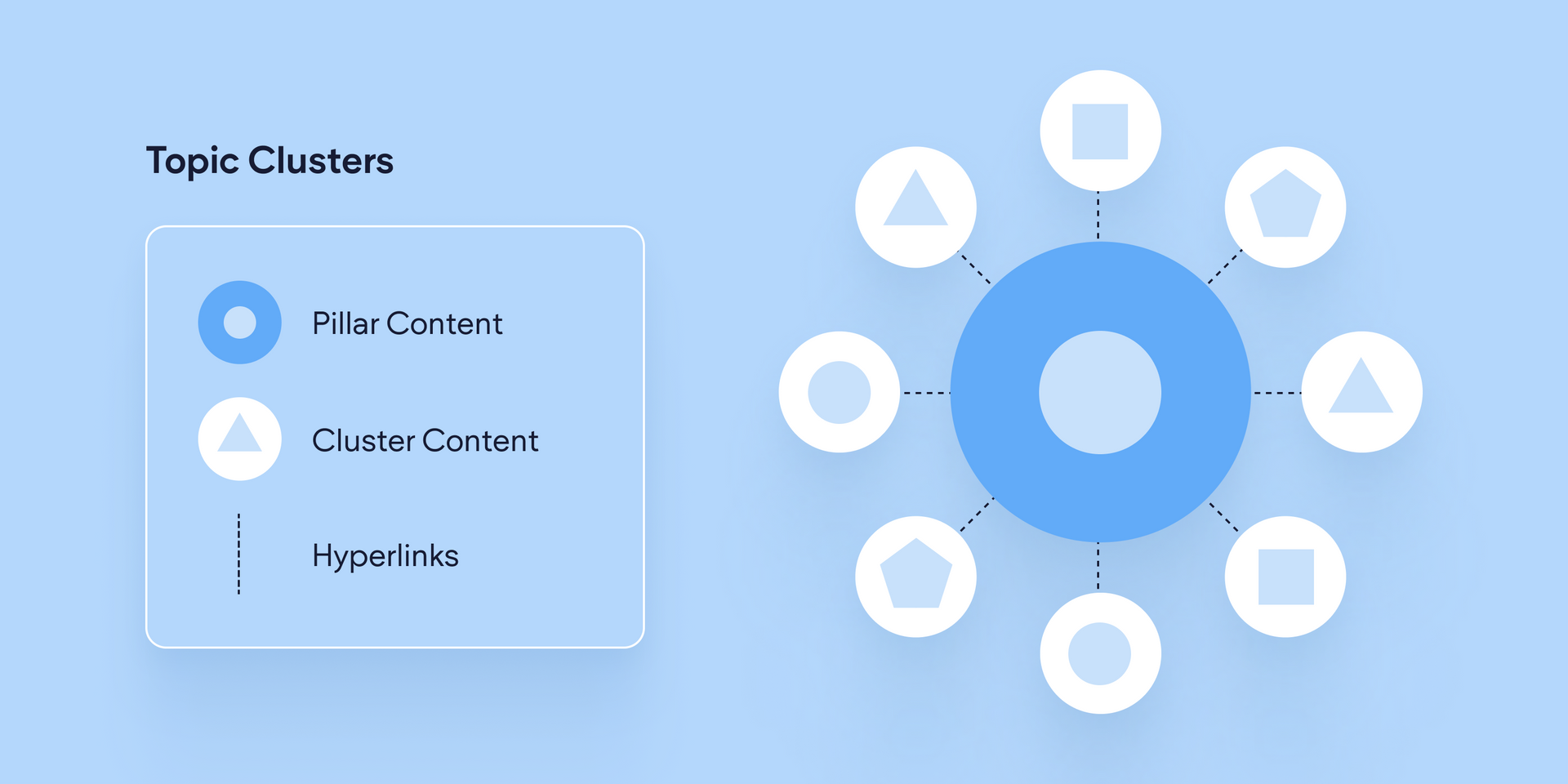Take the guesswork out of content
Imagine if every piece of content you created could seamlessly guide your readers through the buyer's journey, nudging them closer to that pivotal decision point. That’s the power of effective content mapping. In this comprehensive guide, you’ll learn how to align your content with your audience's unique needs and
build content-rich websites that resonate, engage, and convert.
Table of contents
- What is content mapping?
- Who should create a content map?
- Why is content mapping essential for web building?
- Steps to create an effective content map
- Content map example
- Best content mapping tools
What is content mapping?
Content mapping is the process of strategically planning and structuring web content with the goal of converting users from one stage of the buyer’s journey to the next. Going through a content mapping exercise ensures that your client websites present users with the right content at the right time to drive conversions.
Who should create a content map?
Digital marketing agencies and in-house marketing teams responsible for developing and managing web content should create content maps to make sure everyone is aligned on the content strategy–and ensure each piece of content serves a clearly defined purpose.
Why is content mapping essential for web building?
Content mapping is essential in web building because it helps you really focus your efforts on getting the right content to the right audience at the right time to drive desired actions.
A content map helps you create and optimize content and web pages more effectively. It can also create alignment between you and your client, so you can build a user-centric website that not only attracts visitors, but also guides them through the to conversion.
How to create a good content map
Creating an effective content map is a pivotal process for any agency tasked with building client websites. Here's a step-by-step guide:
1. Clarify your goals
Start by establishing clear goals for your client's website and web content. What audience is your client trying to reach, and what business results are they hoping to achieve with their website? How does this tie back to the larger company goals?
For example, for a real estate client, you might articulate the business goals like this:
- The goal of our content strategy is to establish ourselves as the leading real estate authority in [specific area/region]. Our strategy is designed to build trust within the community, grow our online presence, and drive measurable sales by providing valuable content tailored to the needs of our fastest-growing segment: first-time homebuyers.
Next you’ll want to clarify the
how with a content mission statement, like this:
- Our content strategy empowers first-time homebuyers with essential knowledge and tools for a confident journey to owning their first home.
The key is to be crystal clear about your client’s business goals–including who they’re targeting and the specific actions they want to drive–and how their website and content will support these goals.
2. Research your audience
Understand your client's ideal customer profile (ICP) by researching their demographics, interests, and online behavior. There are many different ways to research your client’s audience.
Get direct feedback. Conducting customer surveys and interviews can be a great way to get direct feedback from your clients’ target audience, and help you understand the type of content that will be valuable to them in researching solutions and making a purchasing decision.
Dig into the analytics.
Use Google Analytics and social analytics, like Facebook Audience Insights, to understand your clients’ user demographics, including location, age, gender, interests, and more.
Understand the competitive landscape. Take a look at your clients’ competitors to see how other companies in their vertical are engaging with a similar audience.
3. Create buyer personas
Now it’s time to develop buyer personas representing the different segments of your client's audience. These personas should include demographic information, interests, pain points, and motivations.
Most clients will have more than one persona. For example, a travel agency's personas might range from budget solo travelers to luxury family vacationers. Each persona will have a different path to purchase, typically requiring different types of content to help move them along in the customer journey. Here are a few helpful characteristics to consider including in a buyer persona profile:
- Demographic data: Think age, gender, location, interests, etc.
- Professional data:
Think job titles, income, company size, etc.
- Key motivators:
What gets this audience excited? What keeps them up at night?
- Pain points:
What problems do they have that your client can solve?
- Points of influence:
What type of content do they consume? What thought leaders or influencers do they follow? What sources of information do they trust?
- Buying habits:
How and where they make purchases? Do they make purchasing decisions alone or are there other parties involved? What is their budget? What might influence them to not make a purchase?
4. Understand the customer journey
Each stage of the customer journey requires a unique approach to content. Understanding these nuances is key to developing a content strategy that not only attracts but also nurtures and converts leads, and ultimately fosters customer loyalty.
Top of Funnel, or Awareness Stage
The top of the funnel is all about generating awareness and attracting potential customers. Your client's audience at this stage is just beginning to recognize a need or problem and starting to look for information. They’re not ready for a sales pitch just yet. They’re simply learning and looking for trusted sources of information.
Focus on educational, informative, and engaging content that helps them solve their problem. This content should be easily accessible and shareable to maximize reach. That means the content should be ungated (no pesky forms) and optimized for specific keywords that a user might search for if they’re having a particular problem.
Just think of this very blog post. You probably found it because you need to create a content map for a client and aren’t sure where to start, or you saw it on social media and thought, “I should learn how to do that!”
You’re not looking to buy anything…yet 😉. And good thing for you, we’re not trying to sell you anything either!
Middle of Funnel, or Consideration Stage
At this stage, potential customers are considering different solutions to their identified problem. They're evaluating options and looking for more specific, detailed information. Content at this stage should position your client as a knowledgeable and trustworthy solution provider.
This is where a lot of your web content will come into play. Case studies, how-to guides, webinars, detailed product or service pages, and FAQs are all very effective types of mid-funnel content. This is also a great stage to introduce comparison content, helping users see why your client's solution is the superior choice.
Bottom of Funnel, or Decision Stage
At this stage, the potential customer is ready to make a decision. They're looking for that final push or reassurance to choose your client’s product or service. The content at this stage should be focused on conversion–whether that’s
an online transaction or a phone call to your clients’ sales team.
Bottom of the funnel content often includes product demos, customer testimonials, reviews, and enticing calls to action. For example, a spa client trying to drive online gift card purchases for the holidays might deliver
a well-timed pop-up to returning web visitors promoting a limited-time offer or exclusive package.
Even if they’re not running a special promotion, a client like this might prominently feature a compelling customer testimonial on their services page, showcasing the rejuvenating experiences previous customers have had when visiting the spa. They might also pull Google Reviews into service pages to further build confidence and drive action.
Post-Purchase
The post-purchase stage is often overlooked, but it is essential for customer retention and advocacy–and web content plays an important role. The goal here is to ensure customer satisfaction, encourage repeat business, and turn customers into brand advocates.
At this stage, you’ll want to focus on content that enhances the customer experience with your client's product or service. This could include user guides, ongoing education, and exclusive offers for returning customers. For example, a fashion retailer might create style guides or care tips for purchased items.
5. Map out content ideas along the path to purchase
Now it’s time to get down to business and map everything out. For each persona and each stage of the journey, you need to decide what kind of content will guide them to the next phase. Here’s a content mapping template to get you started.
6. Evaluate existing content
Odds are, your client will already have some existing content that can be repurposed to fit the new content strategy. A content audit can help you find out. Begin by cataloging your client’s existing content across all platforms.
Assess each piece of content for relevance, quality, engagement, and alignment with current
SEO best practices. Now you can start adding these assets to your content map. From there, it’ll be very clear where there are gaps, and that will help you decide what new content you need to create.
7. Brainstorm topics for new content
To fill the gaps in your content map, you’ll need to come up with a plan for new content. Having a solid understanding of your clients’ audience, their pain points, and the types of content they need to move them down the funnel will make it easier to define topics.
You can also feed all of the audience and business intel you have on your client into an AI tool like ChatGPT to generate topic ideas for each persona and stage of the journey.
8. Create content clusters
If you’re handling content creation for your client’s
SEO, you’ll want to take your content map beyond the basic web pages and build out content pillars and clusters. This involves creating a pillar page that provides an overview of a key topic, and then linking it to a more detailed cluster of content that focuses on specific aspects of that topic.
An example of a pillar page for a financial services firm might be a comprehensive web page on the topic of retirement planning. The pillar page would then link off to additional content that dives into specific subtopics of retirement planning. This might include blog posts about investment strategies, how to plan for healthcare costs in retirement, the differences between traditional and Roth IRAs, and more–all of which link to each other and back to the pillar page.
This strategy improves SEO performance because it demonstrates to search engines that the site is a valuable resource on a particular subject.
9. Research keywords for each topic cluster
To get the most out of a pillar/cluster strategy, you’ll need to choose the right keywords. Understand the search intent behind the keywords. Are users looking for information, a product, or a service? Tailor the content to match this intent. Analyze what keywords competitors are ranking for and identify opportunities to target gaps in their content.
It's also important to consider keyword search volumes and difficulty. Search volume indicates how many times a keyword is searched per month, helping you gauge its popularity. However, high search volume often comes with high competition. So you’ll also need to evaluate keyword difficulty, which measures how hard it would be to rank for a specific keyword.
Balancing high-volume keywords with those of lower difficulty can create a more effective strategy. You can get keyword search volume and difficulty insights from tools like
Google Keyword Planner,
Semrush, or
Moz, allowing you to refine your content clusters with keywords that are not only relevant but also achievable and impactful in driving traffic to your client’s site.
10. Build your content calendar
A content calendar is a schedule that outlines when and where content will be published, ensuring consistent and timely content delivery.
Consistency and Timing:
Plan the frequency of your posts and align them with key dates or events relevant to your client's industry. For example, a fashion retailer might align content with fashion weeks or seasonal changes.
Platform-Specific Content:
Tailor content for different platforms. The tone and style for social media posts will differ from blog articles or email newsletters.
Flexibility: While consistency is key, your content calendar should also allow for flexibility to accommodate trending topics or urgent content needs.
11. Establish content KPIs
Establishing key performance indicators (KPIs) for your content map is essential to measure the success of your content strategy and make data-driven decisions for future content planning. KPIs help you and your client understand how well the content is meeting business objectives and engaging the target audience.
Start by aligning KPIs with your client's overall business goals. For example, if the goal is brand awareness, relevant KPIs might include website traffic, social media reach, and time spent on site. For lead gen, focus on conversion rates, number and quality of leads generated, and cost per lead.
Engagement Metrics
Track engagement metrics such as page views, social shares, and average session duration. These metrics are crucial for understanding how well the content is resonating with your target audience.
SEO Performance
Monitor SEO-related KPIs like keyword rankings, organic traffic, and backlinks. This is particularly important for content aimed at improving search engine visibility. Regularly reviewing these KPIs can help you continuously fine-tune your client’s SEO strategy.
Conversion Metrics
For content aimed at driving conversions, track metrics such as click-through rates (CTR), conversion rates, and the number of completed goals (like form submissions or downloads).
You’ll also want to tailor KPIs to each client’s specific needs and regularly review them to ensure they remain aligned with changing business objectives and market conditions.
Content map example
OK, so what does a content map actually look like? Let’s say your client is an auto shop that specializes in restoring classic cars. Here’s what your content map might look like.
Best content mapping tools
Creating an effective content map requires the right tools to research, plan, and execute your content strategy. Here are the best tools I personally use for content mapping.
Audience research tools
Google Analytics
Google Analytics is more than just a tool for measuring website traffic. It offers deep insights into user behavior patterns, such as how long users stay on a page, which pages they visit, and the path they take through your site.
This data is crucial in understanding what content captures and retains user interest, and which pages might need improvement. With features like audience segmentation, you can drill down into specific groups' behavior, tailoring your content strategy to different demographics or interests.
SparkToro
SparkToro goes beyond traditional analytics by offering insights into your audience's broader online presence. It can reveal which social platforms your audience frequents, the podcasts they listen to, and the websites they visit.
This information is invaluable for understanding what types of content resonate best with your audience and where to focus your content distribution efforts. SparkToro can also help you identify key influencers and thought leaders in your industry, offering opportunities for partnerships or co-marketing initiatives.
SEO research tools
Semrush
Semrush is a comprehensive SEO tool that offers more than just keyword research. It provides detailed site audits, highlighting technical SEO issues that could be hindering your site’s performance.
Its competitive analysis feature allows you to see how your content stacks up against competitors, giving insights into their top-performing pages and the keywords they're ranking for. This can guide your content strategy to fill gaps and capitalize on less competitive keywords.
Google Search Console
Google Search Console is an essential tool for understanding how Google views your website. It not only shows which queries bring users to your site but also highlights any crawl errors that could prevent your pages from being indexed properly. For example, the Page Experience report offers insights into factors like mobile usability and Core Web Vitals, helping you optimize for a better user experience and potentially higher search rankings.
Content planning tools
ChatGPT
Use
ChatGPT to quickly generate content ideas, draft outlines, and even create initial content drafts quickly. I recommend starting a new chat for each client. Before you ask ChatGPT to do anything else, you’ll want to teach it about each client. Input everything you know about your client’s business and audience personas. Once you’ve established this information, the AI bot will be able to give much better answers to future prompts.
LucidChart
LucidChart is a visual workspace that provides diagramming and data visualization capabilities. It can be used to create comprehensive user personas, mapping out their needs, behaviors, and pain points. This visual representation helps in aligning content strategies with user expectations and creating a more personalized user journey.
Content management and personalization tools
Duda
A Content Management System (CMS) is essential in bringing your content mapping strategies to life.
A robust CMS like Duda enables you to craft and publish personalized content targeting personas at various stages of their buyer's journey.
For example, Duda is uniquely equipped with
advanced personalization features that offer extensive flexibility in how content is displayed to different users. Duda uses a combination of triggers (like time of day, geolocation, and user behavior) and actions (such as pop-ups, notification bars, or custom JavaScript) to power dynamic content adaptation, deliver engaging experiences for each visitor, and drive more conversions.
You can also use
dynamic pages and connected data to create hyper-personalized landing pages at scale–in a fraction of the time it would take to build each page individually.
Content mapping is key to success
Content mapping is crucial for agencies committed to delivering outstanding results and driving client success. By aligning content with each audience persona and lifecycle stage, agencies can greatly increase user engagement and satisfaction, turning their clients’ prospects into loyal customers and brand advocates.













